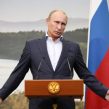
MOSCOW STUNG BY ESTONIAN BAN ON TOTALITARIANISM’S SYMBOLS
Publication: Eurasia Daily Monitor Volume: 4 Issue: 19
By:

Russia’s government, parliament, and state-controlled media are redoubling the anti-Estonian campaign in the wake of the Estonian parliament’s adoption of the “Law on the Protection of War Burial Sites” (January 10) and the first-reading passage of legislation against public display of totalitarian symbols (January 24).
The first law paves the way for relocation of the Soviet Soldier’s monument from downtown Tallinn to a less conspicuous location on the outskirts of town, most likely a war-graves site. The second piece of legislation — a bill of amendments to the penal code — would ban the politically motivated display of Soviet and Nazi symbols in public places. The bill enumerates those symbols as the flags, coats of arms, other attributes, and slogans of the USSR, the Communist Party of the Soviet Union, Germany’s Nazi party NSDAP (National-Socialist Party of the German Workers), and its SS organization. Under this bill, offenders would be referred to courts where they face penalties ranging from fines to prison terms of up to three years.
Official Moscow’s response ignores the ban on Nazi symbols while taking indignant offense at the ban on Soviet symbols and the expected relocation — misrepresenting it as destruction — of the Soviet Soldier’s monument.
On January 17, Russian Minister of Foreign Affairs Sergei Lavrov described the expected relocation as a “blasphemy” and “fraught with serious consequences for Russia-Estonia relations.” On the following day, the ministry summoned Estonia’s ambassador, Marina Kaljurand, and delivered a protest note along the lines of Lavrov’s statement.
On January 17 and 24, respectively, Russia’s Duma and the Federation Council passed resolutions appealing to parliaments of former Soviet republics, those of Western countries, the anti-Hitler coalition, the Council of Europe, and various international organizations to condemn Estonia. The Federation Council added a threat that Estonia’s legislation could “spark a crisis between the Estonian and Russian nations.” For its part, the Duma added a reaffirmation its own November 2006 resolution on purported “Neo-Nazi and Revanchist Moods in Estonia.” Moreover, the Duma now recommended to Russian President Vladimir Putin to consider the possibility of introducing economic sanctions on Estonia, in accordance with Russia’s December 2006 law conferring authority to the president to impose “special economic measures” against other countries.
The authorities organized anti-Estonian rallies and pickets on January 24 in a number of cities across Russia. In Moscow, some 2,000 members of the governing party United Russia, its youth organization Young Guard, the pro-Kremlin youth movement Nashi, and — unusually — the xenophobic movement Mestnyie, joined in a rally at Marshal Zhukov’s monument. Nashi leader Vasily Yakimenko implausibly threatened in his speech to send 300 “commissars” (a designation for Nashi activists) into Estonia to guard the Soviet Soldier monument round the clock.
The threat of economic sanctions also lacks credibility. Politically, Russia has demonstrated that it can impose wide-ranging economic sanctions on Georgia and Moldova for reasons that have nothing in common with interpretations of history or ideology, but only for perceived disobedience vis-à-vis Russia. Moreover, the Kremlin directly orchestrated those economic sanctions in 2005 and 2006 well before the December legislation that conferred that authority to the president. Compared to Moldova and Georgia, however, Estonia is far less vulnerable, since Russia accounts for approximately one-tenth of Estonia’s foreign trade.
Putin has displayed relative restraint thus far. Answering journalists’ questions on this issue (which he did not himself raise) in Sochi during German Chancellor Angela Merkel visit, Putin merely opined that Estonia “sought to position itself as front-line state and earn economic and political favors for this.” Putin cited Germany as a positive example for having preserved the Soviet Soldier’s monument in Berlin (Kommersant, January 22).
The analogy is inapposite, however, on at least two counts. Germany, a country defeated in war, has accepted this particular symbol of one of the victorious powers in the country’s capital. Estonia, however, did not take part in any war, being simply occupied by two powers successively, the second occupation lasting almost half-century. Second, the notion that Germany’s defeat actually liberated the country from totalitarianism is a notion accepted and internalized by German society, whereas the Soviet occupation — of which the Soviet Soldier’s Tallinn monument is the conspicuous symbol — cemented totalitarian rule over Estonia and her Baltic neighbors.
(BNS, Interfax, January 17 through 25; see EDM, January 11)




